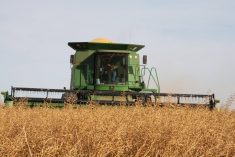SGS Canada had its critics when it set out to replace grain commission inspections, but the business model worked
Twenty-five years ago, Fraser Gilbert saw an opportunity nobody else did.
Lots of people thought he was dead wrong when the former top grain quality man from the Canadian Grain Commission decided to plunge into the CGC’s traditional role of inland grain inspections and offer a private sector alternative.
Today, many now expect that alternative to almost entirely supplant the government’s role on the Prairies.
Read Also

New program aims to support plant-based exports to Asia
Understanding the preferences of consumers in Taiwan and how they differ from Indonesia or Malaysia isn’t easy for a small company in Saskatchewan.
“The time was right,” said Gilbert in an interview at the Canadian Pulse and Special Crops Convention, which SGS Canada sponsored.
It was through special crops that SGS in Winnipeg first began creeping into a western Canadian grain industry with which it had previously had little success.
“I personally thought that the business was there.”
Indeed, it was. From his work at the grain commission, Gilbert knew that some buyers and traders would prefer inspections from third party sources to those offered by government or from the Canadian exporter.
While inspections had long been offered from port positions by SGS and others, complementing the CGC’s inspections and documentation, doing it deep inside the growing region wasn’t something that had worked well for the private sector.
As a 1999 story in the Western Producer said, “to date, most of SGS’s grain business in Canada has involved exports of special crops. It also provides analysis and documentation for inter-company trading in Canada and inspects samples submitted by producers, dealers or processors.
“But SGS has grander plans, saying the CGC should limit its activities to regulations and setting standards, and leave the job of verifying commercial sales and contracts to private inspection agencies.”
Inside Canada, that’s mostly become the case as the private inspectors have expanded and CGC has lost some of its traditional roles. Many expected the commission to lose all inspection services a decade ago, but then the federal Conservative party fell from power and the Liberal party took the helm. It did not reverse reductions to the CGC and preserved it in its contemporary form.
With a federal election looming, Gilbert thinks the time for the private inspectors to fully supplant the CGC might soon be at hand.
“We expect after this election … that change will in fact take place,” said Gilbert.
There aren’t many complaints from the special crops industry or other Canadian crop industries about the privatization of inspection services. It’s become the new status quo.
SGS’s prairie operations began in Winnipeg and expanded to Saskatoon. Gilbert said growth among Canada’s other crops has been promising. It is now actively pursuing expansion into U.S. crop production zones.
In global terms, SGS is a giant, with 99,600 employees, 2,600 offices and laboratories and major operations in ports around the planet. It has been operating for 140 years with its base in Geneva.
Gilbert was enjoying working his company’s booth at the convention, chatting throughout the show with scores of customers from around the world and taking in the energy of the bustling sector.
“It’s just a vibrant industry,” said Gilbert.


















